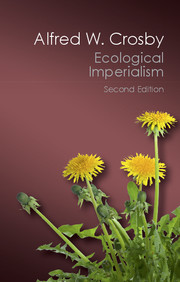Book contents
- Frontmatter
- Dedication
- Epigraph
- Contents
- List of Illustration
- Preface to the new edition
- Acknowledgments
- 1 Prologue
- 2 Pangaea revisited, the Neolithic reconsidered
- 3 The Norse and the Crusaders
- 4 The Fortunate Isles
- 5 Winds
- 6 Within reach, beyond grasp
- 7 Weeds
- 8 Animals
- 9 Ills
- 10 New Zealand
- 11 Explanations
- 12 Conclusion
- Appendix: What was the “smallpox” in New South Wales in 1789?
- Notes
- Index
- Frontmatter
- Dedication
- Epigraph
- Contents
- List of Illustration
- Preface to the new edition
- Acknowledgments
- 1 Prologue
- 2 Pangaea revisited, the Neolithic reconsidered
- 3 The Norse and the Crusaders
- 4 The Fortunate Isles
- 5 Winds
- 6 Within reach, beyond grasp
- 7 Weeds
- 8 Animals
- 9 Ills
- 10 New Zealand
- 11 Explanations
- 12 Conclusion
- Appendix: What was the “smallpox” in New South Wales in 1789?
- Notes
- Index
Summary
“Perhaps it is the very simplicity of the thing which puts you at fault.”
–Edgar Allan Poe, “The Purloined Letter”If we confine the concept of weeds to species adapted to human disturbance, then man is by definition the first and primary weed under whose influence all other weeds have evolved.
–Jack R. Harlan, Crops and Man (1975)As constituted at present, New Zealand's biota and society, as well as those of the other Neo-Europes, are largely products of the runaway propagation and spread of what I call the portmanteau biota, my collective name for the Europeans and all the organisms they brought with them. Understanding its success is the key to understanding the puzzle of the rise of the Neo-Europes.
Adam Smith said of the success of one of the portmanteau biota's more prominent organisms, “In a country neither half-peopled or half-cultivated, cattle naturally multiply beyond the consumption of its inhabitants.” He was among the wisest of men, but neither a historian nor an ecologist, and we might want to ask him why said country is so lightly populated and farmed, and, further, to point out that in most places and most times, with or without humans present, the increase of cattle and indeed all organisms is naturally kept within decent bounds by the actions of predators, parasites, pathogens, and hunger. Events to the contrary were in such profusion in Smith's time as to dazzle his common sense.
The triumph of the portmanteau biota has been massive in the Neo-Europes, but most of the extreme predictions of such nineteenth-century naturalists as W. T. L. Travers have proved to be exaggerated. Very few of the indigenous life forms of the Neo-Europes have become extinct, and in North America and Australasia the native peoples are now increasing faster in number than the descendants of their conquerors. Yet the indigenes are only small fractions of the total populations, and there is no scoffing at the number of invading organisms that have thrived and swarmed across the Neo-Europes. The present-day biotas of these lands are very different from what they were a few human generations ago. The magnitude of the change has been more accurately assessed by its human victims than by its human beneficiaries.
- Type
- Chapter
- Information
- Ecological ImperialismThe Biological Expansion of Europe, 900–1900, pp. 269 - 293Publisher: Cambridge University PressPrint publication year: 2015

